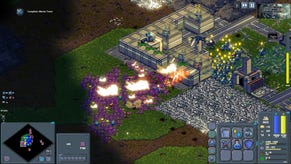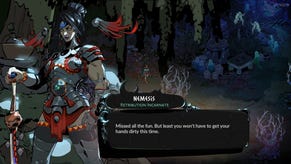Valve On Steam Greenlight's Failings, Fixing Them
Communication Breakdown?
Over the weekend, I attended Fantastic Arcade, an indie-focused gaming show in Austin, Texas. It was - as is often the case with these things - full of passion, creativity, and the guy who played that one kid in Dazed and Confused. You'll be hearing tons more about it soon. First, though, we'll look at what was perhaps the most incongruous moment of the event: a Valve panel. Steam Greenlight, of course, has had some pretty serious ups and downs since launching, and this panel gave the very people who are fighting to set up shop on the ubiquitous storefront a chance to voice their complaints directly. Here's how it all went down.
Generally, I like to save the moral of a story for the post-car-chase conclusion, but Fantastic Arcade's Steam panel had roughly one theme: confusion. Between rapid change and some less-than-clear communication on Valve's part, it's been tough for many developers (not to mention potential players) to stay in the loop. And so, somewhat fittingly, the session's Q&A kicked off with developers attempting to pinpoint what exactly Valve's hoping to achieve with Greenlight in the first place. After all, Steam's old selection process is still ticking along in the background, and many devs both large and small are bypassing Greenlight entirely for its greener pastures. So who should go where?
“Greenlight's for games we don't really know how to evaluate – from developers we don't know or haven't heard of necessarily,” replied designer Alden Kroll. “They can even be from other publishers whose games haven't done well in the past, so we don't know how to prioritize those. So it's to answer those questions about what the community wants to see.”
“In addition to that, the section for concepts and future projects – we really envision that being an area that you guys can use to talk to your fans early on,” added business developer Augusta Butlin. “So even though we may have an established relationship and, yes, we would more than likely take the game when it's ready, we still think that being able to talk to your fans super early is going to be of value to you.”
“It might be one of those games we would've taken anyway, but it doesn't have to be binary. It doesn't have to be Greenlight or talk to us. It can be both.”
Meanwhile, Greenlight's been undergoing rapid evolution, growing new arms and leg fast enough to make heads spin (and, in turn, sprout extra noses). Much of it, though, has been a rather silent process. Even after official announcements via blogs and whatnot, developers and players have been left shrugging their shoulders. On the dev side, it's that pesky $100 fee. Potential players, meanwhile, can no longer see any ranking data about their favorite prospects. What followed, of course, were multiple questions to the effect of “Wait, why?”
And while Valve was hesitant to discuss the fee beyond what it previously stated, it did open up about rankings. In short, the previous system was skewed too heavily in favor of those already at the top. It simply wasn't fair.
“We consciously designed Greenlight to not be a self-reinforcing cycle of the top games getting votes because they're in the top,” explained Kroll. “There was initially this big confusion over why there's no top-rated list. Well, for exactly that reason. We don't want a few people to overly influence the system by being early voters and getting things to the top. We don't want something getting voted up because everyone's piling on it.”
“Previously, probably 80 or 90 percent of games were at one percent. That's why we ended up changing that metric. So [formerly low-ranking games] are probably a lot closer to shipping than that reflected. We're seeing now that we've changed the system, a lot of developers are really talking to their communities and telling them how they're doing. They're talking about those things and trying to keep community support going.”
More than anything else, Valve continued to drive that point home: Greenlight isn't meant to be a free ride straight to the top. For developers, the focus should be on initiative and self-sufficiency. Without rankings, the system's less organized and more chaotic than ever, but right now, that's the point. It's on developers' shoulders to form communities both on and off Steam, and it's also their duty to point the way to their game's Greenlight page.
“I think this applies not just to people on Greenlight, but selling games on Steam in general. [Success comes from] using channels outside of Steam. We have a big audience, sure, but Steam is not going to be a golden ticket necessarily. You also have to work on marketing and getting buzz out there. Getting people excited about your product. There's a lot of people on Steam, but they're not there every day looking at the front page.”
As is, then, Greenlight's less of a magical, crowd-powered game factory and more of an anything-goes gladiatorial arena. Unfortunately, that leaves non-developers like me and probably you in a bit of a tight spot. For normal folks, digging through more than a thousand candidates (and counting) without any rhyme or reason simply isn't, well, reasonable. As a result, promising games are still bound to slip through the cracks – which is what Valve designed Greenlight to avoid in the first place. So what's the next step? How does Valve give attention to deserving games while also continuing to encourage its – at least, in theory – open, developer-driven system?
“That's definitely another concern that we're trying to figure out how to test for and handle,” Kroll answered. “We're kind of walking this delicate balance between having a crowd-sourced system where the fans feel like they're being heard and their input is valuable, and us having the ability to pick things across the crowd's selection of genres that may suit an audience that's not participating in Greenlight at all. How do you peek in and ship some things that maybe aren't getting traction? But we want to make sure Greenlight is serving its full purpose – and not just the things that are popular.”
“Evidence we've seen so far is that a surprising variety of games are getting voted up to the top. But it's also hard to figure out if something's getting missed, so we're trying to figure out how to test for that. For instance, we might find something that's really interesting and could succeed as a playable game, but may not be doing so well as just a video. So how do we make sure we're not missing that?”
Right now, Valve fully admits that it doesn't have an answer. But Greenlight's also still new to this whole existing thing, and it's far from assuming any sort of final form. For better or worse, it's the kind of thing that's not really possible to test in the lab, so it's got a bumpy road ahead of it. From the looks of things, communication will continue to be a serious issue (For instance, Kroll also noted that the actual schedule for greenlighting games isn't concrete and can vary according to all tons of internal factors – which is all kinds of problematic for devs. Also, this is Valve we're talking about), but the underlying intentions are obviously good.
If nothing else, though, remember what Steam was like when it first launched? Slow and steady wins the race. It was probably Gabe Newell who first said that. He just took too much time to take credit.











